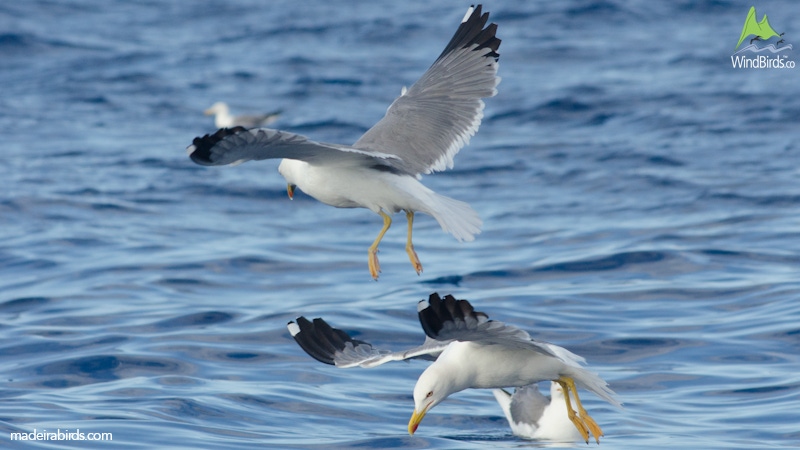Yellow-legged Gull Larus michahellis Naumann, 1840
Order: Charadriiformes Family: Laridae Status: Breeding in Madeira

Recommended birdwatching tours & sea trips to watch this bird
Bird, dolphin and whale watching trip
Zino’s Petrel Pelagic Expedition
Half-day birdwatching
Yellow-legged Gull Field ID Keys
Shape & Size
A medium to large sized gull with long wing projection, long legs and heavy, blunt-ended bill.
Colour Pattern
These very abundant seagulls have a medium light grey back and the adults have yellow legs and a red orbital ring. The bill is also yellow with a small red mark at the end. Juveniles have streaked grey-brown bodies with dark bills and pinkish legs.
Behavior
Yellow-legged gulls like to gather around areas with food availability as fishing harbours or rubbish dumps though in Madeira they can easily be watched all around the coast. Their flight is strong due to its large wings but when gliding its wings are normally arched.

Habitat
This species is found in all islands of the Madeira archipelago as well as the Canary Islands, the Azores and along the Mediterranean coasts.
The Yellow-legged Gull is found in a great variety of habitats, preferring quieter locations such as small islands and coastal cliffs to spend the night and nest. During the day, these birds are commonly seen in large numbers in areas where there is food abundance, namely, around fish markets or harbours and refuse dumps though it is easily seen in smaller groups near the coast all around the islands of Madeira and Porto Santo.
Distinction from similar species
Immature birds are always difficult to distinguish from other species of medium-sized gulls and adults are similar to Herring Gull and to Lesser Black-backed Gull. The Herring Gull has a paler back and pinkish legs while the Lesser Black-backed Gull has darker back and dull yellow legs.
Larus michahellis Biometrics
Wingspan: 138 - 155 cm (Beaman & Madge, 2011)
Total length: 55 - 67 cm (Beaman & Madge, 2011)
Weight: 750 - 1200 g (Hume, 2002)
Other Bird Facts
Seasonality in Madeira: All year
Breeding: There are large nesting colonies on the islet of Cevada (São Lourenço peninsula) and on Chão islet (Desertas islands). This species of gull nest in May with just one brood of 2 to 3 eggs.
Diet: It eats anything that is available, though its preference should be fish, molluscs and offal from the ocean or ground.
Status
Madeira local status by Correia-Fagundes et al, 2021: Very Common breeding bird
Madeira local status by Romano et al, 2010: Very Common breeding bird
Madeira local status by Zino et al, 1995: Very Common breeding bird
Conservation status by the IUCN Red List Categories, 2013: Least Concern ver 3.1
Name of this species in other languages
Portuguese: Gaivota-de-patas-amarelas
German: Mittelmeermöwe
Dutch: Geelpootmeeuw
Swedish: Medelhavstrut
Danish: Middelhavsmåge
Finish: Etelänharmaalokki
Norwegian: Gulbeinmåke
Spanish: Gaviota Patiamarilla
French: Goéland leucophée
Italian: Gabbiano reale
Polish: Mewa romańska
Slovak: čajka žltonohá
Czech: Racek středomořský
English synonyms: Mediterranean Herring Gull